Production Notes - The Spy Who
Loved Me
With Harry
Saltzman now out of the picture, having sold his shares
in Danjaq to United Artists, Albert
R. Broccoli was left in sole
control of the Bond series of films. But he had a problem to
deal with when starting pre-production on the next film. Both
"Live
and Let Die" (1973) and" The
Man With the Golden Gun" (1974) had
been sluggish at the box office and United Artists' response
was
to throw twice as much money into the new film as they had invested
on "Golden Gun" in an attempt to rejuvenate
the
ailing series.
The Fleming
novel chosen to be the tenth official was to be
'The Spy Who
Loved Me', a strange, experimental work that barely
featured
Bond at all. Fleming had been aware of the novel's shortcomings
as potential film material and it was the only one of the canon
that had a rider attached - before his death, Fleming had insisted
that if EON were to use The Spy Who Loved Me, then they should
take the title only and must come up with their own storyline.
|
Broccoli commissioned a number of writers to work on fashioning
the script into something suitable, among them Stirling
Silliphant, John Landis, Ronald Hardy, Anthony Burgess
and Derek Marlowe.
Eventually, it would fall once again
to Richard Maibaum to build the framework for Bond's
latest adventure and at first he tried to incorporate ideas
from
all of the other writers into his script.
This proved
just too cumbersome, though it has been suggested that
some
of the other writers' work does survive through to
the finished film - the submarine silo, for example, is
said
to have come from Anthony Burgess.
Maibaum's original pass at "The
Spy Who Loved Me" featured an alliance of international terrorists
storming SPECTRE's headquarters and deposing Blofeld before trying to destroy
the world for themselves to make way for a New World Order.
Broccoli
quickly stomped on this first draft, dismissing it as
too political and it was back to the drawing board
for Maibaum. |
|
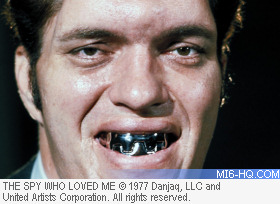
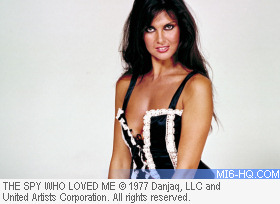
|
Meanwhile, Guy
Hamilton, who had overseen the previous three
Bond films, none of which had done as well as his debut in the
series, "Goldfinger" (1964), was
originally penciled in to direct
"The Spy Who Loved Me". But while the film was in pre-production,
the Salkind brothers were preparing their epic "Superman:
The Movie" (1978) and Hamilton decided that he wanted to be
free to pursue the possibility of directing for the Salkinds
instead.
This left the way open for Lewis
Gilbert to
return to the fold, almost a decade after his success with "You
Only Live Twice" (1967).
When he read Maibaum's script, he recommended that Broccoli bring
in another writer, Christopher Wood, to have a go at polishing
it into shape. Wood was better known under his nom de plume,
Timothy Lea, author of the successful Confessions... series
of books and
the subsequent hugely popular film series.
|
Wood reworked Maibaum's script, keeping the notion of
a super tanker that swallowed up other ships and the new
villain, Jaws, the assassin with the steel teeth. Later,
while the film was in production, successful TV producer
Gerry Anderson began to smell a rat. Back in the early
70s, Harry Saltzman had asked
Anderson and his colleague Tony Barwick to write a script
based on the novel Moonraker.
This the couple duly did, penning a script that featured
an oil tanker that made off with and fired nuclear missiles.
Some friends of Anderson's [among them effects maestro
Derek Meddings] were working on The Spy Who Loved Me and
had shown Anderson a copy of the script - which, of course,
also dealt with an oil tanker.
Deciding that Maibaum and Wood's script
was a little too reminiscent of his and Barwick's treatment
for Moonraker,
Anderson instructed his lawyers to begin legal action against
Broccoli. But, as he explained in Gerry Anderson - The
Authorised Biography, "My lawyers weren't show business
lawyers, so I was really in a very weak position. I must
confess I became very frightened, and after a few weeks
decided to drop the matter." Anderson agreed to accept
a nominal payment of £3,000 from EON on the agreement
that he handed over the treatment and destroyed any other
copies. |
|
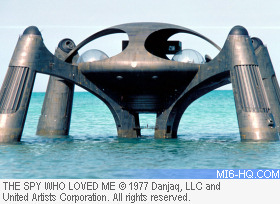
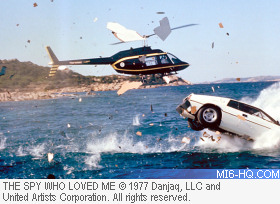
|
Wood's proposed changes to Maibaum's draft script
were agreed by Broccoli, but before he could set to work, there
were more
legal complications. In the years since "Thunderball"
(1965),
Kevin McClory had
set up two film companies and, collaborating with
Sean Connery and novelist Len Deighton, had been trying to get
a new Bond film off the ground. McClory had got wind of Broccoli's
plans to use SPECTRE, an organization that had first been created
by Fleming while working with McClory and Jack Whittingham on
the very first attempt to film Thunderball, back even before
it was a novel, in
the late 1950s.
McClory threatened to sue Broccoli for alleged copyright infringement,
claiming that he had the sole rights to use SPECTRE and its agents,
including Blofeld. Not wishing to get into what could have been
a lengthy legal battle that could have delayed production on The
Spy Who Loved Me, Broccoli ordered Wood to take out any references
to SPECTRE in his script.
|
For the part of Russian agent Anya Amasova,
Broccoli had originally wanted former model Lois
Chiles.
But enquiries to her agent revealed that Chiles was, supposedly,
in temporary retirement. The truth was that Chiles had
been hurt by one of her critical notices [which dismissed
her as "no more than a table decoration"] and
was taking acting lessons in New York. Instead, the part
went to former model Barbara
Bach, the future Mrs Ringo
Starr.
With Ken
Adam back on board and with a much larger budget
than of late, it was inevitable that we were going to get
a Bond on a grand scale. So grand, in fact, that Bond's
traditional home at Pinewood simply didn't have anywhere
large enough to house Adam's latest extravagance, the interior
of Stromberg's massive super-tanker.
Broccoli's answer was to begin work, in March 1976, on
the construction of a whole new sound stage at Pinewood,
the enormous 007 Stage, the largest stage anywhere in the
world. To complement this 374 x 160 x 53 foot tall monstrosity,
Eon also paid for the building of the largest water tank
in the industry, capable of taking some 1,200,000 gallons. |
|
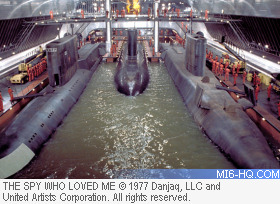
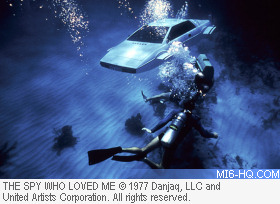
|
At a time when Britain was gripped by a severe
drought and the water shortages that went with it, this was seen
by some as an
unnecessary extravagance, though EON maintained that the water
they used was taken from a natural well buried beneath the stage.
While construction on the massive Liparus set continued, the
second unit, headed by John
Glen, set off for Asgard Peak in Baffin
Island, Canada where, in July 1976, they staged the film's much-loved
pre-credits sequence - Bond's audacious escape from his pursuers
by skiing off a cliff edge and sailing to freedom beneath his
union jack parachute. Bond film veteran Willy Bogner was on hand
again to capture the action which was staged by stunt man Rick
Sylvester who earned a well deserved $30,000 for the highly dangerous
stunt.
The main unit began its work in August 1976,
traveling first to Sardinia and later to Egypt for some of the
film's key early
scenes. While in Sardinia, Moore got to drive the first of two
Lotus Esprits that were to feature in the film. The second,
specially
modified model [nicknamed 'Wet
Nellie'] was unveiled by Ken Adam
and Derek Meddings in October when the second unit, this time
supervised by Michael
G. Wilson, traveled to Nassau to film the
many underwater sequences.
Back in Egypt, the crew visited Cairo's spice market, the Gyer-Anderson
museum and, of course, the Giza pyramids. During the shoot, however
the crew was caught in a food shortage, requiring Broccoli himself
to step in and save the day by cooking spaghetti for his hungry,
100 strong cast and crew.
The production returned briefly to the UK to shoot at the Faslane
submarine base before setting off to Spain, Portugal and the Bay
of Biscay where the super tanker exteriors were filmed. On 5 December
1976, with principal photography finished, the massive 007 Stage
was formally opened by Prime Minister Harold Wilson at a star
studded ceremony.
The Spy Who Loved Me opened with a Royal
Premiere, attended
by Princess Anne, at the Odeon Leicester Square in London on
13 July 1977. The subsequent premiere party was hosted by Broccoli
at the Intercontinental Hotel in Park Lane and itself cost £143,000.
Over dinner, Broccoli raised the potentially tricky topic of
Moore's commitment to the series. Moore's original contract with
EON had tied him to only three films, all of which had now been
made. But Broccoli need have had no worries - Moore was only
to keen to keep on going and readily agreed to appear in the
next film, which Broccoli was already planning to be "For
Your Eyes Only".
When it opened to the public, "The Spy Who Loved
Me" proved to be a much more successful venture than the disappointing
"The Man
With The Golden Gun". American attendances reached 21 million
and eventually, the film would gross $185.4 million dollars
world-wide.